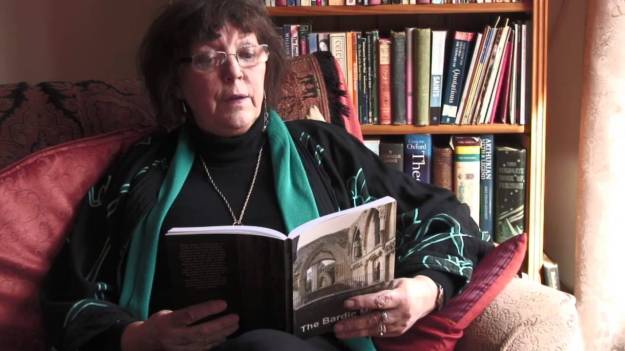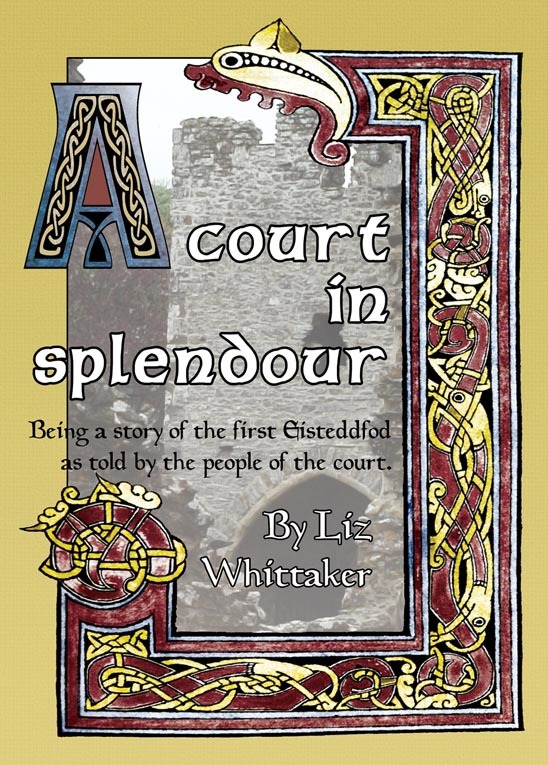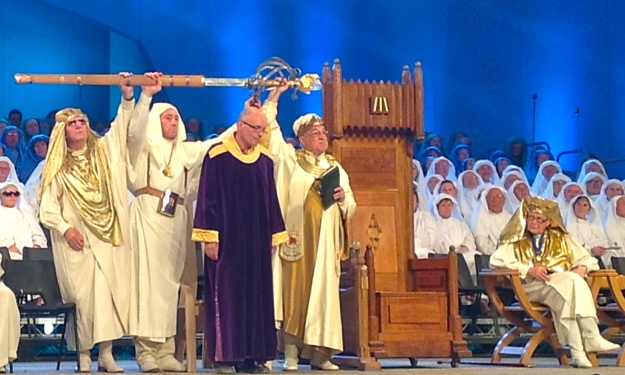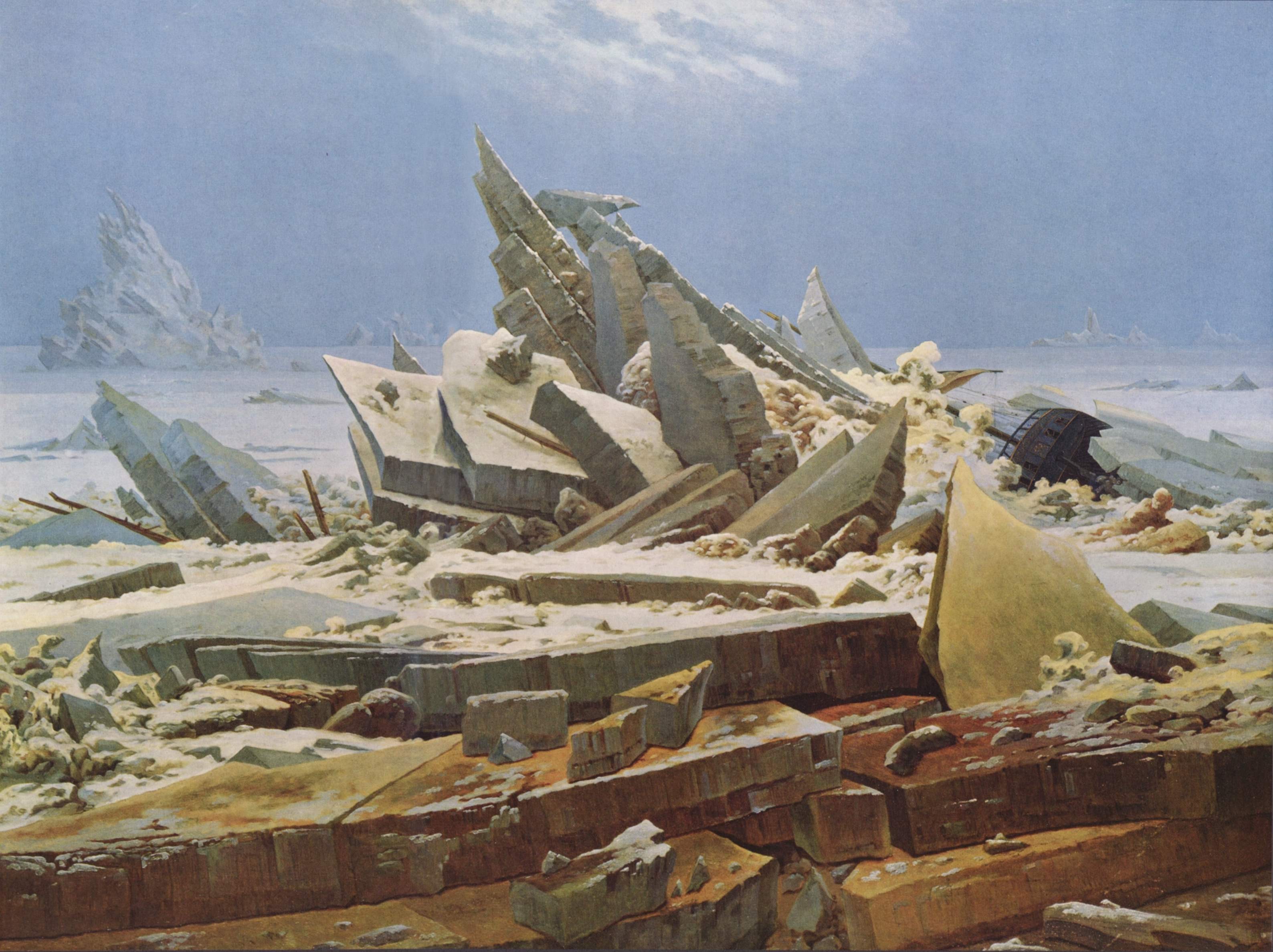

I first encountered Liz Whittaker whilst busily organising the book section in Ty Hafan the children’s charity shop in Cardigan, where I was volunteering. My eyes were met by intelligent lively and inquisitive eyes. Her first question was why are you here? I was somewhat taken aback by this opening, not most customers first question. I explained that I lived in a cottage called Crugmawr in Penparc just 3 miles from Cardigan and had retired here from the civil service. She then repeated her question, yes she was right I had not answered it fully! I told her I was bored with retirement as I was still only in my 50s and looking for an outlet, and hence I was volunteering in the charity shop and helping out at the local castle making costumes for children to wear as re-enactments of the Eisteddfod. I then had the temerity to ask her who she was!!
It turned out that she was a local journalist and author, who held storytelling events for children. During our chat, she told me all about the history of the Battle of Crugmawr between the Welsh and the Vikings and that she had written a book about the Eisteddfod. We had numerous chats in the shop over the years until she died about 2 years ago. I am fortunate in that I own her own annotated copy of the book.
Her enthusiasm for Wales and writing stayed with me after that, when this assignment appeared I was filled with anxiety as I had no idea what to write about until I thought of her and her boundless energy for writing something I do not enjoy. The book I have chosen is hers and I hope her love of Cardigan and all things Welsh comes through in this brief essay.

Eisteddfod

rhys ap gruffydd
Cardigan
The Priest’s Story.
(in which Father Rhygyfarch tells the story of how he came to serve The Lord Rhys ap Gruffudd and the role he played in assisting Rhys to deliver Cardigan into the hands of the Welsh. He looks forward to the great Feast of Poets and Bards at Christmastide.
23rd of December at the priests house of the holy Trinity church Cardigan
Why would I tell my story to anyone, let alone the King of England’s man? I have given much thought to this for many hours since Walter Map appeared on my doorstep and made his strange request. But I have come to see that I would regret it if I did not take the opportunity to tell my tale, for what is a man but the story leaves behind at the end of his days? The memories of a man in his old age are surely the deeds of a man in his prime, and to share my greatest moments is a blessing to me, not a duty; though memory brings not only the great moments, but the moments we would prefer to forget.
When there is a mist on the river as there is this morning, flickering pictures lap in with the tidal flow, and images come sharp to my inner eye, making me turn inwardly away from myself, in an anguish as my mind conjures them without my consent, and I am forced to endure again those moments long gone when I was chaplain on the battlefield. Here is a man stumbling toward me through the mist, screaming for help… Is he coming for me? I see the gushing blood pouring from him, his ravaged incomplete face, etched forever on my brain. Then all is silent. The mist swirls about us as I move toward him, and he is dead at my feet, eyeless and dead. I will not remember. I will not look longer on this again for I know that opening the door of my mind to it brings behind a legion of horrors best forgotten. So I shake my head, a firm shake that dislodges the risen ghosts, and when I turn again to look at the river I glimpse the silver of a darting fish, see a standing heron dip its sharp beak to lift the squirming arc into the air, and toss it back into its gullet, and by an effort of will I am returned to the present.
This is reality. This bright morning with its low river mist and its promise of a cold clear day to come. This is my here and now. Not blood- drenched fields of battle on which I must stand in attendance to hear men’s prayers, confessions, and give the last rites…
Those days are gone. At least they are gone for now, and may God provide they will never come again. The snaking mist no longer hides and then exposes me to terrifying sites of slashing swords and flying arrows and men mutilated, dying and dead.
I chose this book because it is about where I live. It is about a subject that I have a lot of interesting in as it is about where I live now. It explores the place of Cardigan and time of Reece Ap Gruffudd, the Welsh Prince who delivered Cardigan into the hands of the Welsh. The time is 1176 in the reign of King Henry II, it is written by a man called Walter Map, a clerk and recorder in service of the king. He tells us that as a young man in Paris he studied the works of the Great Masters, Ovid to Vergil, Horace, Plautis and more. He was sent by the King to discover more about the Eisteddfod and to investigate the Lord Rhys and the people of Wales. Rhys Gruffudd is a puzzle and an enigma, being a true and stalwart Welshman who also claims loyalty to the Crown and still so loved by his own countrymen. To discover the truth of Prince Rhys he gathers the words of three people who lives bring them closer to Rhys than most people, Rhygyfarch his priest, Gwenllian his wife and Hwyel Sais, his son.
The narrative is told from the point of view of each person and of those three people each one is a different character, and tells the story from a different perspective. The plot is simple and straightforward. Each person tells the story of how they are connected or involved or served the Lord Rhys ap Gruffudd. The structure is very straightforward, the book contains three individual stories, the language is simple as it would be told by people of that era, but using a generally modern idiom. The author says her aim is in allowing the storytellers to tell their stories and to make their words readily accessible to the contemporary reader and create a sense of being there. She hopes she succeeds in this.
The book is a work of fiction based on the historical evidence available surrounding Christmas at Cardigan Castle in 1176 where the first Eisteddfod was celebrated. All the characters whose voices are here, were real figures important in the life of Lord Rhys and the narrator Walter Map was in fact, King Henry II’s Clerk.
The priest’s story, Father Rhygyfarch, is told from his point of view and the opening paragraphs invite one to consider a number of questions. What church does he belong to, what were the battles that he saw, who were the people who were killed, how did he come to be in Cardigan, was he born there, did he move there?
The language is very straightforward, it isn’t particularly poetic, it talks about time, in his words “for what is a man but the story he leaves behind at the end of his days? The memories of a man in his old age are surely the deeds of a man in his prime.”
He wants to share those memories, the land is described very simply, we become aware that there is a river which has mist on it and ” flickering pictures lap in with the tidal flow”. He talks of a battle, we know men have died there as he describes the mist swirling about him as he moves towards a man and” he is dead at my feet, eyeless and dead ” . He will not remember as that it would open legions of horror is best forgotten.
He dislodges the risen ghosts and “glimpses the silver of a darting fish and sees a standing heron dip its sharp beak to lift the squirming arc into the air”. It is nature, reminding him to turn back, to be mindful of the moment, to be spiritual.
It’s a bright morning with a low river mist and promise of a cold clear day to come, this is his here and now, that mindfully brings him away from the horror. He hopes that those days will never come again and “the snaking mist no longer hides and then exposes to me the terrifying sites of slashing swords and flying arrows and men mutilated, dying and dead. The mist is a theme that runs through that short paragraph, we have a vision of a river misty herons fish and a clear cold day.
I really enjoyed this opening, it intrigues me as to where the story was going to go. How this simple priest had come to be on a battlefield and how he became to be involved with Prince Rhys Gruffudd. It was interesting to know more about the Eisteddfod, which as a lady from Sussex living in Wales it was fascinating to discover more about that time and era , particularly as I live on the site of the Crugmawr battle. I have been fortunate to make some are Eisteddfod costumes for the local Cardigan Castle and have done a considerable amount of research into the costumes and the history.
The book tells the first-person stories of the people of that time and of Lord Rhys himself who gathered everybody together for a contest of Welsh bards and musicians and the resulting awarding of a chair for their merits music and poetry.
When there is a mist on the river as there is this morning, flickering pictures lap in with the tidal flow, and images come sharp to my inner eye, making me turn inwardly away from myself, in an anguish as my mind conjures them without my consent, and I am forced to endure again those moments long gone when I was chaplain on the battlefield.
The reference to mist and the bodies, actually reminded me of a favourite painter of mine, Casper Friedrich David, his ability to represent the sublime has always appealed to me.

Chalk Cliffs on Rugen (1818/1819)
It is through language that the sublime object – be it craggy cliff, charnel house, or graveyard – could be related to our fears of pain, death, and destruction, where the objective could be tied to emotional.
A Philosophical Enquiry into the Origin of Our Ideas of the Sublime and Beautiful (1757)
“Whatever is fitted in any sort to excite the ideas of pain, and danger, that is to say, whatever is in any sort terrible,or is conversant about terrible objects, or operates in a manner analogous to terror, is a source of the sublime; that is, it is productive of the strongest emotion which the mind is capable of thinking…. When danger and pain press too nearly, they are incapable of any delight, and are simply terrible; but at certain distances, and with certain modifications, they may be, and they are delightful, as we everyday experience.”
‘Rather than in the things of nature, the sublime is to be found only in our own perceptions, when our inability to estimate the magnitude of things makes us aware of a super sensible faculty within us. This is the paradox of the sublime.’ The Sublime, Iain Boyd Whyte, from Beyond The Finite – The sublime in art and science. (OUP 2011).
Kant ” The beautiful in nature has to do with the form of the object, which consists in the boundary. The sublime, on the other hand, is to be found in a formless object, in so far as in it or by occasion of it boundlessness is represented, and yet its totality is also present to thought.”
The diminutive figures in the foreground peer tremulously down into the abyss formed by the chalk cliffs and spiky outcrops that plunge down into the Baltic on the island of Rugen. The sequence of the three figures seem to exemplify the Kantian sublime, the woman on the left pointing down in initial horror at the incomprehensible magnitude of the drop below. The male to her right, momentarily incapacitated as his rational imagination fails to rise up to the vertiginous challenge before him. The third figure leans nonchalantly against a tree, a safe vantage point on the wondrous spectacle as fear is transformed into joy in the experience of the sublime. Friedrich himself observed, “To live eternally once, we must often surrender to death” -The Sublime Iain Boyd Whyte as above.

Wanderer above the mist.
Mist is also a symbol of the mixture of Air, Water and Fire which existed prior to the creation of solid matter, like the original as it was before the six days’ Creation and before all things were given their shape.
Japanese painters often depict horizontal or vertical mists (kasumi). They denote a break in the thread of a story, a transition in time-scale or a passing into a world of fantasy or wonder.
Some Irish literary sources associate fog or mist with the music of the Otherworld (sid) or with the Otherworld itself. The Voyage of Bran speaks of a ‘lovely mist’ which conjures up or symbolizes indistinction, the period of transition between two states of being. Similarly, when Senchan Torpeist sends his son Muirgen to raise the soul of King Fergus to teach him the tale of the cattle-raid of Cooley, which no poet then knew in its entirety,
Muirgen stood on the rock and sang as if addressing Fergus himself… A thick mist encompassed him… Then Fergus came to him, finely clad, in a green cloak, hooded tunic embroidered in red, with a golden-hilted sword and bronze shoes and his hair was brown. And he taught him the whole of the cattle raid of Cooley, as it had happened, from beginning to end.
Thus mists are regarded as preludes to important revelations, prologues to manifestations.
Mists are often used in films and books that tell of legends and great deeds, but also on the battle fields. They often evoke horror and isolation as well as mystery.

The Sea of Ice (1823–24), Kunsthalle Hamburg Casper Friedrich David

Les Braves War Memorial Sculpture
Room Four of Place Page 100- 101 Kinloch Rannoch, Alexander and Susan Maris, ideas and pictures evoked for me how the landscape might have looked to our priest. https://www.flickr.com/photos/anonymaris/sets/72157625317119344/

Room Three, the pictures of the crop circle, look just as the site of Crugmawr looks with the hill and evokes mist, times past and sleeping dragons.
It also reminded me of a Room Five in the set textbook Place of politics and control, in particular, the story of the silent village, although in no way as horrific as that story. Their efforts to save their way of life (the people of Liddice) reminded me of the Welsh effort to retain their culture.
I find it difficult to say a lot about her technique, not being a writer myself but from what I have learnt during the course I feel that she lets the narrator tell the story themselves There is no sense that there is a writer behind it, as in the essay by TS Eliot Tradition and the Individual Talent. I am hearing the voice of the priest, not the voice of the writer. This writer could have written in more poetic language and used her device to create more dynamic visual language, but she’s chosen not to in this particular book. That is not how the father himself would have spoken, she has allowed the character to shine through, allowed the character to tell the story in his plain and simple language.
Has the prior knowledge of having met this author hindered or helped? In this case, it has definitely helped, I was swimming through muddy waters until I remembered this lady and her book. The fact that it was written by someone I knew about the place I live in and a time I am interested in, making this assignment much easier to approach.
Conclusion
What have I learnt — I am not a writer!! I love reading, but I have never enjoyed analysing the work why? Well to me, it is like going to watch Star Wars and then someone telling me how it was done! That spoils it for me personally. I like to lose myself in the story and though it is interesting to understand the craft behind the tale, it is not a long-term prospect for me.
I really struggled with the writer’s notebook. I always have, even as I child, I could not keep a diary. It may have come from being forced as a child to write letters. I never knew what to write, though on the phone I can talk for England and Wales! I can write policy documents, recipes, lists to do, essays even experiments ie art journal but complete blank when it comes to diaries etc. I did try but I do not feel I met the criteria for that aspect. I have enjoyed revisiting some of the things I learned from English classes. The psychological aspect of archetypes intrigued me, as did the role of the reader.
Though a creative writing course is not for me, I will definitely be taking the ‘ role of the reader forward’ and some of the way language influences people, as well as mark making and signs. I also found it fascinating to learn about the Hero’s Journey and how writers write novels!
I would like to complete the degree, though for me the learning is more important. As a mature student, I am probably more decisive about my direction which is definitely painting, mixed media and textiles, but I really enjoy the rigor of the creative arts academic challenges.
Academically I am fairly strong, but I have to discipline myself to sit at a computer for the length of time it takes to produce good work. I spent 30 years at a desk so can find it difficult, but that is about balance which I am working on.
I would like to pass through to next year, but am not looking to do so with flying colours as they used to say. I am looking to do the best I can on all elements, but am aware at my time of life that there are areas I will be stronger on, than others. I see from the requirements that all five assessments should be submitted. I look forward to your feedback on this part. I am currently reading further to your suggestion War and Art which my husband kindly bought me for Christmas!






